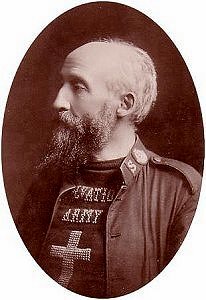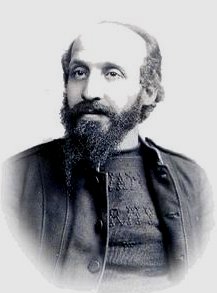Introduction

Born: July 6, 1849, Arbroath, Scotland.
Died: July 9, 1913, Cologne, Germany.
Buried: Abney Park Cemetery, London, England.



Born: July 6, 1849, Arbroath, Scotland.
Died: July 9, 1913, Cologne, Germany.
Buried: Abney Park Cemetery, London, England.


George was the son of Methodist missionaries Lancelot Railton and Margaret Scott.
He was first Commissioner of the Salvation Army (SA), and second in command to SA founder William Booth.
George was educated at Woodhouse Grove School in Leeds. After his parents died when he was 15, he found himself homeless and jobless.
His older brother, Launcelot, a Methodist minister, found him work in London with a shipping company, but not finding it to his liking, George went to Morocco in 1869 as a missionary
Being unsuccessful and finding himself stranded in Morocco, he worked his passage back to Britain as a steward.
In 1870, he began to work in Stockton-on-Tees for an uncle who owned a shipping business, but preached the Gospel at every opportunity.
The same year, William Booth met George’s brother Launcelot, who told him of George’s attempt to convert the Moroccans, adding that George was just the sort of person that Booth’s Christian Mission was looking for
Two years later, Booth received a letter from George, who had read the Christian Mission’s How to Reach the Masses with the Gospel, and was so moved by it that he offered himself to the cause.
In October 1872, Railton traveled to London to begin his work for the Christian Mission (renamed the Salvation Army in 1878 at a meeting Railton attended), and for some years he lived in the Booth household as William Booth’s secretary.
He became acting editor of The Christian Mission Magazine, and in September 1873 was appointed General Secretary to the Christian Mission.
By 1880, Booth’s son Bramwell had matured and became his father’s secretary. Railton, who since his youth had wanted to be a missionary, persuaded Booth to send him to New York to begin the SA’s work there.
He was well suited to such work, being a skilled linguist, dedicated, and hard working, and both he and his superiors felt more comfortable with him on the frontier than at headquarters.
With male officers being few in number, Railton took Captain Emma Westbrook and six other young women with the intention of training them for the work on the voyage to America.
On March 10, 1880, Railton arrived at Castle Garden, New York with his seven Hallelujah Lassies,
and immediately set about preaching to New Yorkers and joining with the unofficial work already begun by the Shirley family in Philadelphia, Pennsylvania.
He also began the work in Newark, New Jersey, leaving two young women in charge there, while he set off for St. Louis, Missouri, to begin preaching there, but there he was unsuccessful.
Meanwhile, in New York the work had gone so well that by May there were 16 officers, 40 cadets, and 412 soldiers. By the end of 1880, 1,500 had been converted.
In January 1881, Railton received orders from William Booth to return to England. Railton protested that he was needed in America, but Booth insisted he return home.
On January 1, 1885, Commissioner and Mrs. Railton set sail for Natal, South Africa, arriving there on March 8, with Railton’s health declining.
On May 6 they arrived at Pietermaritzburg, where the idea of the SA’s Red Shield Work
for men in the forces came into being. On August 19, 1885 the couple set sail for England.
In 1886, Booth sent Railton to Germany, where his preaching met with considerable hostility, and little progress was made. However, by 1890 Germany had a new Emperor, Wilhelm II, and Chancellor Bismarck being retired, it was thought the situation would improve, and Railton was officially appointed Territorial Commander.
Later that year, he returned to England to conduct the funeral of Catherine Booth, The Army Mother.
In 1893, as part of a tightening of restrictions by the German government, Railton was expelled from the country.
In 1894 Railton was sent to Spain, where he remained until recalled to England in the summer of 1895
Though by now his health was declining, he was called on to assist Bramwell Booth for whom he traveled the world, inspecting the work of the SA.
In 1899 Railton set sail for South Africa to negotiate with the political and military leaders before the launching of the Red Shield work among the troops. Although this was initially difficult, eventually he overcame all the problems.
He returned to England at the end of the Boer War in December 1900, where he remained until being sent to take charge of the work in France towards the end of 1901.
At the end of 1902, Railton returned to work at SA headquarters until 1903, when he left for West Africa to launch the work of the SA there.
On his return in December 1903, his health had deteriorated greatly, and he was not seen in public again until the International Congress in June 1904.
In his later years, Railton continued to travel widely, visiting many countries on behalf of the SA, including China, Japan and Russia.
While traveling to Le Locle, Switzerland, he had to change trains at Cologne, Germany. Having a long wait for his connection he visited the quarters of the local SA officers.
Delayed by their hospitality and their prayers, he had little time to catch his train and ran up the stairs to the platform carrying his heavy bags. On reaching his seat, he collapsed and died of a heart attack.